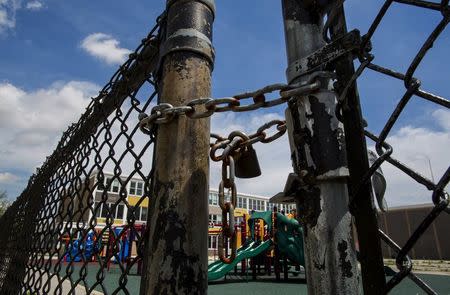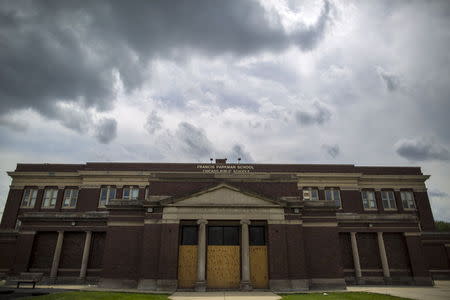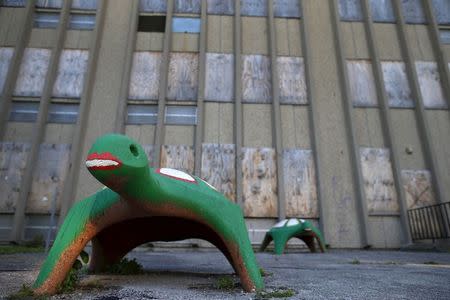Two years on, empty schools pose tough sell for Chicago
By Mary Wisniewski CHICAGO (Reuters) - Sitting at the dead end of a west side Chicago street, the vacant Ward elementary school is a gloomy sight. The three-story building has boarded up windows and graffiti. Dandelions poke through cracks in the parking lot. Two concrete playground turtles, their paint fading, provide seats for drug users, neighbors say. "They should utilize it, or they should tear it down," said neighbor Connie Sims. "It's like an accident waiting to happen." Ward was one of 49 elementary schools targeted by the country's largest mass closing in 2013, and most are still empty two years later. Under-enrollment and low resources were cited by school board officials for the closures, which mainly affected poorer African-American and Latino neighborhoods. The shuttered buildings have become a vivid symbol of the fight over Chicago Mayor Rahm Emanuel's sweeping drive to reform education and tackle a projected $1.1 billion education budget deficit. Chicago's teachers' union is fiercely opposed to turning the sites into charter schools - privately run and usually non-union - while residents say the empty buildings have become sources of blight and activists say the process to find new uses has been painfully slow. "They went and closed a record 50 schools with no plan," said Valerie Leonard, a West Side community organizer. The Chicago public schools system says finding new uses has taken time because it wants to evaluate all possibilities and consult the public. TOUGH SELL Empty urban schools can be a tough sell, as Detroit, Philadelphia and Kansas City, Missouri, all have found in recent years. According to a 2013 study by Pew Charitable Trusts, vacant school buildings are sometimes in poor condition, their layouts are often not conducive to new uses and some are located in declining residential areas. In March, Detroit's school system transferred 77 of its 98 closed schools to the city, which can use federal dollars to tear some down while rehabilitating others, said school spokeswoman Michelle Zdrodowski. One abandoned high school is about to become part of an automotive plant. Of Philadelphia's 34 shuttered schools, sales are closed or pending for 25, said spokeswoman Raven Hill. Forty percent of closed schools in the United States became charters, the Pew study found. Others found new life as housing and community centers - scenarios that also were envisaged in Chicago by a February 2014 advisory committee. However, the charter option has long been a political challenge in Chicago, where public school teachers held an eight-day strike in 2012 over Emanuel's reforms and his support of charter schools. Although Chicago Public Schools, or CPS, had previously pledged not to go the charter route, it enraged its teachers' union last month by saying it would consider turning some closed sites into charter schools if communities wanted them. One such proposal already has been approved. "This is a betrayal of the Board's promise to not allow charters to snatch up closed schools," said Chicago Teachers Union staff coordinator Jackson Potter. Andrew Broy, president of the Illinois Network of Charter Schools, said charters should be able to access vacant school buildings if there is no other viable use for them. "The longer we wait to do so, the more those buildings deteriorate," Broy said. SPENDING AND SAVING The 38 empty school buildings are costing Chicago's cash-strapped system more than $3 million a year for utilities, security and other maintenance, official figures show. CPS said it avoided $430 million in capital costs over 10 years by closing the schools. It spent $233 million on refurbishment for schools that took in displaced students. So far, Chicago has found new uses for four emptied buildings - one became an arts academy, another a testing center. Sales are pending for two buildings - including one that will include an expanded charter - and requests for proposals have gone out for three, officials said. CPS spokesman Bill McCaffrey said finding new uses has been a "deliberate process" of evaluation because officials saw what happened in other cities when a building was sold off too quickly, and then became "an albatross." "We knew this would take some time and we wanted the community to have a chance to express their wishes," said McCaffrey. Yet there have been no community meetings since November 2014, and none are currently scheduled. Asiaha Butler, a community activist in the South Side's troubled Englewood neighborhood, said she hates to see closed public schools among so many other vacant homes and businesses. Some have become targets for vandalism, according to police reports. In April, vandals broke windows not only at Englewood's closed Yale Elementary but at surrounding homes as well, said Butler. "It really hurts your heart," she said. The Chicago advisory report acknowledged that the evaluation process cannot go on forever, and recommends demolishing remaining facilities in mid-2016. Residents hope that something - anything - happens soon. "They ought to do something - tear it down, make it a strip mall," said Lisa Pruitt, who works as a church secretary near the boarded-up Ross Elementary, with its mutilated U.S. flag mosaic and cracked blue playground slide. She remembers when the South Side's Washington Park neighborhood was beautiful. "It's a bit of a desert now," said Pruitt. (Reporting by Mary Wisniewski, editing by Jill Serjeant and Dan Grebler)

 Yahoo News
Yahoo News 


